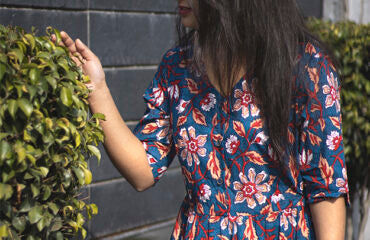India’s rich and vibrant culture has been reflected in Indian prints, dyes and fashion. There are many talented artisans across the various states of the country that produce some immensely gorgeous fabrics using skillful techniques of printing, dyeing and weaving. In this blog we introduce you to some of these techniques popular in the western states of Rajasthan and Guajarat resulting in the most colourful and spirited fabrics.
Bandhani
Tie-dye is probably one of the most well-known technique of India. An ancient technique, it began around 5,000 years ago in Rajasthan and Gujarat. Because of its old history, Bandhani is the oldest method still in use, and was traditionally used for sarees, odhnis and turbans and now contemporary clothing uses it for dresses, jumpsuits and more. Traditionally, brides wear Bandhani sarees for good fortune as it represents luck. Bandhani technique is generally performed on cotton and silk fabrics where the fabric is tied tightly at certain places to make a a a pattern. It is then dipped in for a dye bath of vibrant colours where the tied areas resist the colour, Once done, the fabric is washed, starched, and precisely pulled apart to release tied knots and voila! You have a beautiful Bandhani design.
Leheriya
Like Bandhani, Leheriya is a traditional style of tie-dye mainly practiced in Rajasthan, however the Leheriya method is usually used to make intricate wave patterns. Leheriya is usually done on lightweight fabrics such as mul cotton, kota cotton, georgette etc. You make it by rolling the fabric diagonally from one corner to the opposite selvage, tying it to the required spaces, and dyeing it. Another similarity Bandhani and Leheriya share is that they both use natural, non-damaging dyes. For instance, in traditional Leheriya, you use natural dyes and after washing the cloth multiple times, at the final stage of preparation, there is a use indigo or alizarin, an organic compound.
Block Printing
Now that we have talked briefly about Bandhani and Leheriya, we will move on to block printing. This one is a little different. Instead of using a tie-dye technique, in block printing, you dye/color the fabric using wooden blocks. This unique art started around 3500-1300 BC and has grown to be one of the most famous Indian techniques. Two popular types of prints are Rajasthan’s Dabu prints and Gujarat’s Ajrakh prints. And there are so many more, from Sanganer’s famous Callico prints to Bagru’s Syahi Begar prints. You might be curious about how block printing is done. Well, most importantly, you need to get blocks. Blocks are made using specific wood; teak, sycamore, and pear, and then carved into intricate designs, first made on paper. Then, they are dipped in oil for 10-15 days. The fabric needs to be washed and pinned to a printing table, while the colors are prepared being kept on a tray holding glue and pigment binder. Since the blocks are ready, they’re dipped in color and pressed onto the fabric precisely, repeating that until every designated spot on the fabric is covered. Then, the fabric is dried in the sun and steamed, washed in water, dried in the sun again, and ironed. Then you’ve got your beautiful, block printing work of art. In addition to all of this, block printing respects the planet and nature with its sustainability and natural colors.

